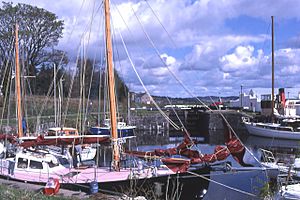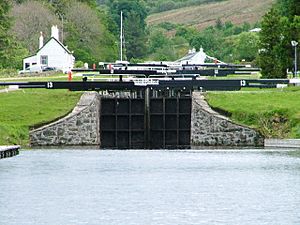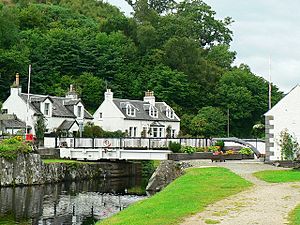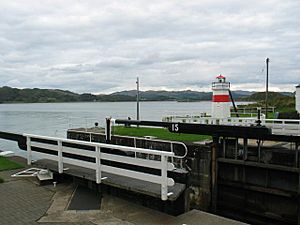Crinan Canal facts for kids
The Crinan Canal is a cool waterway in western Scotland. It connects two villages, Crinan and Ardrishaig. Scottish Canals looks after it. This canal opened way back in 1801. It's named after Crinan village, where it starts on the west side.
It's about 9 miles (14.5 km) long. It links Loch Gilp (near Ardrishaig) to the Sound of Jura. This means boats can travel between the Clyde and the Inner Hebrides islands. They don't have to go all the way around the windy Kintyre peninsula.
Contents
Why Was the Crinan Canal Built?
The Crinan Canal was built to create a shortcut for boats. Before the canal, ships had to sail a long, dangerous way around the Kintyre peninsula. This was especially tricky around the Mull of Kintyre, which is very exposed to bad weather.
The canal made it much easier for commercial sailing boats, fishing boats, and later, Clyde puffers (small steamships). They could travel between the busy industrial area around Glasgow and the villages and islands of the West Highlands.
Building the Canal: A Tricky Job
The famous engineer John Rennie designed the canal. Work began in 1794. It was supposed to be finished in 1799, but it took longer. The canal finally opened in 1801.
Building the canal was not easy. There were many problems:
- Money troubles: It was hard to get enough money for the project.
- Bad weather: Storms and heavy rain caused delays.
- Land prices: Landowners asked for a lot of money for their land.
- Workers: It was tough to find enough navvies (canal builders).
In 1805, part of the canal bank near Lochgilphead broke. The canal's path had to be changed to avoid marshy (swampy) ground. Then, in 1811, a huge storm caused a reservoir to burst. Water, rocks, and mud rushed down the canal. This damaged the locks, canal banks, and nearby roads.
Improvements and Royal Visits
The canal company, led by the Duke of Argyll, asked the government for help. Thomas Telford, another famous engineer, looked at the problems. He suggested making the locks better. Some parts of the canal were redesigned. The old swing bridges were replaced with new ones made of cast iron in 1816.
The government paid for these repairs. After this, the Caledonian Canal Commissioners took over running the Crinan Canal.
A very special visitor came to the canal in 1847: Queen Victoria! She traveled along the canal during her holiday in the Scottish Highlands. She was met at Ardrishaig. Her boat was pulled by four horses. Two of the horses had riders called postilions, dressed in royal livery (uniforms). At Crinan, she got onto her royal yacht, the Victoria and Albert.
The Queen's journey made the canal very popular with tourists. Passenger boat companies from Glasgow started calling it the "Royal route." By the late 1850s, over 40,000 passengers used the canal each year. In 1866, a steam-powered boat called Linnet started carrying tourists. It replaced the horse-drawn boats and was used until 1929.
The Canal Today
Between 1930 and 1932, new sea locks were built at both ends of the canal. This meant boats could use the canal no matter what the tide was doing. A new swing bridge was also put in at Ardrishaig.
In 1962, British Waterways became responsible for the canal. Today, Scottish Canals looks after it. The canal is very popular with people who enjoy boating for fun. Nearly 2,000 boats use it every year.
The path next to the canal is also part of National Cycle Route 78. This cycling route connects places like Campbeltown, Oban, Fort William, and Inverness.
The Crinan Canal is considered a special historical site. It is a "scheduled monument," which means it's protected. Loch a' Bharain, a lake that supplies water to the canal, is also a protected monument.
What Features Does the Crinan Canal Have?
The Crinan Canal has 15 locks. Locks are like water elevators that help boats move up or down between different water levels. The stone for these locks came from islands like Mull and the Isle of Arran.
The canal also has seven bridges:
- Six of them are swing bridges, which swing open to let boats pass.
- One is a retractable bridge, which rolls back.
From Ardrishaig, the first three locks raise the canal's water level by about 32 feet (9.8 meters). The highest part of the canal, between Cairnbaan and Dunardry, is about 64 feet (19.5 meters) above sea level. The canal is about 10 feet (3 meters) deep. Boats can be up to 2.5 meters (8.2 feet) deep to use it.
The retractable bridge at Lock 11 was put in place in 1900. You turn a handle and a cogged wheel. This makes the bridge deck roll forwards and backwards on rails. It then rests across the lock chamber.
The canal used to have towpaths on both sides. Horses would pull boats along these paths until 1959.
| Feature | Location | Type |
|---|---|---|
| Lock 1 (sea lock) | Ardrishaig | Lock |
| Ardrishaig Swing Bridge | Ardrishaig | Swing bridge |
| Ardrishaig Basin | Ardrishaig | Basin |
| Lock 2 | Ardrishaig | Lock |
| Lock 3 | Ardrishaig | Lock |
| Lock 4 | Ardrishaig | Lock |
| Lock 4 Bridge | Ardrishaig | Swing bridge |
| Oakfield Bridge | Lochgilphead | Swing bridge |
| Lock 5 | Cairnbaan | Lock |
| Cairnbaan Bridge | Cairnbaan | Swing bridge |
| Lock 6 | Cairnbaan | Lock |
| Lock 7 | Cairnbaan | Lock |
| Lock 8 | Cairnbaan | Lock |
| Lock 9 | Dunardry | Lock |
| Lock 10 | Dunardry | Lock |
| Lock 11 | Dunardry | Lock |
| Dunardry Bridge | Dunardry | Moveable bridge |
| Lock 12 | Dunardry | Lock |
| Lock 13 | Dunardry | Lock |
| Bellanoch Bridge | Bellanoch | Swing bridge |
| Bellanoch Marina | Bellanoch | Marina |
| Crinan Bridge | Crinan | Swing bridge |
| Lock 14 | Crinan | Lock |
| Crinan Basin | Crinan | Basin |
| Lock 15 (sea lock) | Crinan | Lock |
Images for kids
See also
 In Spanish: Canal de Crinan para niños
In Spanish: Canal de Crinan para niños








